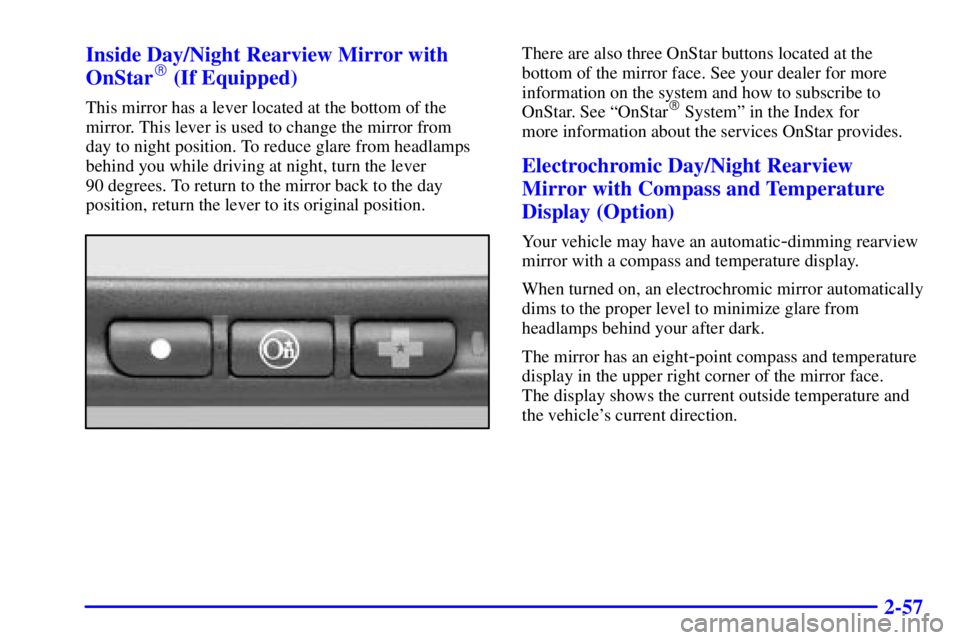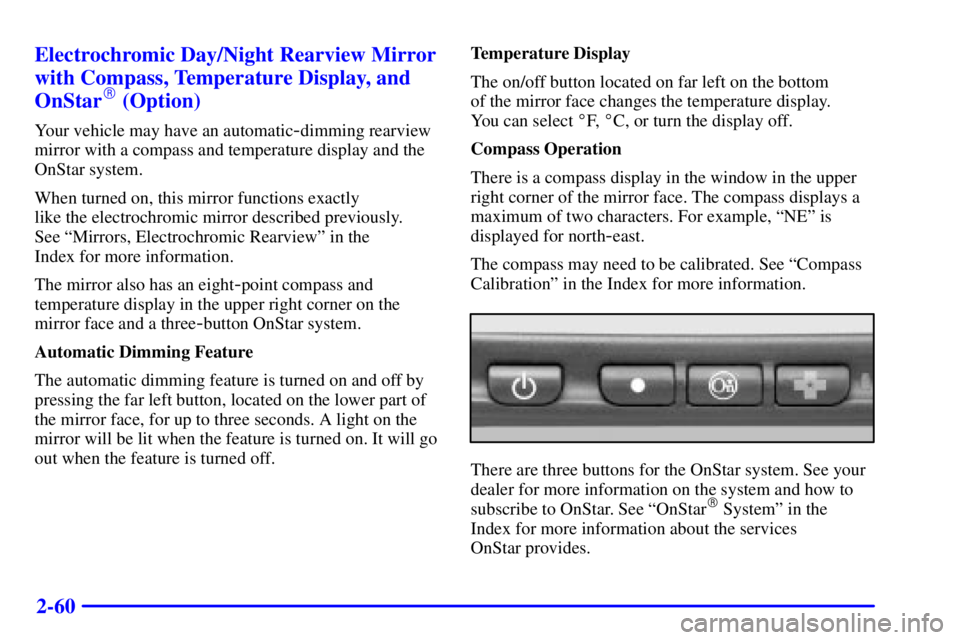Page 125 of 373

2-56 Overhead Console Reading Lamps (Option)
These lamps are part of the overhead console. They will
go on when you open the doors. When the doors are
closed, push the button next to each lamp to turn
them on and off. The console also contains an open
storage bin.
Front Reading Lamps (Option)
If the vehicle has the optional sunroof, you will have
reading lamps in front of the sunroof switch. Press the
button behind each reading lamp to turn them on
and off.
Rear Assist Handle Reading
Lamps (Option)
There is a reading lamp provided in each rear assist
handle. Use the button next to each lamp to turn it
on and off.
Battery Saver
Your vehicle has a feature to help prevent you from
draining the battery in case you accidentally leave the
interior, trunk or underhood lamps on. If you leave
any of these lamps on while the ignition is in LOCK or
OFF, they will automatically turn off after 10 minutes.The lamps won't come back on again until you do
one of the following:
�Turn the ignition to RUN or ACCESSORY.
�Turn the interior lamp thumbwheel completely to the
right, then back slightly to the left.
�Open (or close and reopen) a door that is closed.
If the vehicle has less than 15 miles (25 km) on the
odometer, the battery saver will turn off the lamps after
only three minutes.
Mirrors
Adjust all the mirrors so you can see clearly when you
are sitting in a comfortable driving position.
Inside Day/Night Rearview Mirror
To reduce glare from lamps behind you, pull the lever
located in the center of the bottom of the mirror toward
you to the night position. To return the mirror back to
the day position, push the lever away from you.
Page 126 of 373

2-57 Inside Day/Night Rearview Mirror with
OnStar
� (If Equipped)
This mirror has a lever located at the bottom of the
mirror. This lever is used to change the mirror from
day to night position. To reduce glare from headlamps
behind you while driving at night, turn the lever
90 degrees. To return to the mirror back to the day
position, return the lever to its original position.
There are also three OnStar buttons located at the
bottom of the mirror face. See your dealer for more
information on the system and how to subscribe to
OnStar. See ªOnStar
� Systemº in the Index for
more information about the services OnStar provides.
Electrochromic Day/Night Rearview
Mirror with Compass and Temperature
Display (Option)
Your vehicle may have an automatic-dimming rearview
mirror with a compass and temperature display.
When turned on, an electrochromic mirror automatically
dims to the proper level to minimize glare from
headlamps behind your after dark.
The mirror has an eight
-point compass and temperature
display in the upper right corner of the mirror face.
The display shows the current outside temperature and
the vehicle's current direction.
Page 129 of 373

2-60 Electrochromic Day/Night Rearview Mirror
with Compass, Temperature Display, and
OnStar
� (Option)
Your vehicle may have an automatic-dimming rearview
mirror with a compass and temperature display and the
OnStar system.
When turned on, this mirror functions exactly
like the electrochromic mirror described previously.
See ªMirrors, Electrochromic Rearviewº in the
Index for more information.
The mirror also has an eight
-point compass and
temperature display in the upper right corner on the
mirror face and a three
-button OnStar system.
Automatic Dimming Feature
The automatic dimming feature is turned on and off by
pressing the far left button, located on the lower part of
the mirror face, for up to three seconds. A light on the
mirror will be lit when the feature is turned on. It will go
out when the feature is turned off.Temperature Display
The on/off button located on far left on the bottom
of the mirror face changes the temperature display.
You can select �F, �C, or turn the display off.
Compass Operation
There is a compass display in the window in the upper
right corner of the mirror face. The compass displays a
maximum of two characters. For example, ªNEº is
displayed for north
-east.
The compass may need to be calibrated. See ªCompass
Calibrationº in the Index for more information.
There are three buttons for the OnStar system. See your
dealer for more information on the system and how to
subscribe to OnStar. See ªOnStar
� Systemº in the
Index for more information about the services
OnStar provides.
Page 203 of 373

4-17
Driving at Night
Night driving is more dangerous than day driving.
One reason is that some drivers are likely to be
impaired
-- by alcohol or drugs, with night vision
problems, or by fatigue.Here are some tips on night driving.
�Drive defensively.
�Don't drink and drive.
�Adjust your inside rearview mirror to reduce the
glare from headlamps behind you.
�Since you can't see as well, you may need to
slow down and keep more space between you and
other vehicles.
�Slow down, especially on higher speed roads. Your
headlamps can light up only so much road ahead.
�In remote areas, watch for animals.
�If you're tired, pull off the road in a safe place
and rest.
No one can see as well at night as in the daytime. But as
we get older these differences increase. A 50
-year-old
driver may require at least twice as much light to see the
same thing at night as a 20
-year-old.
What you do in the daytime can also affect your night
vision. For example, if you spend the day in bright
sunshine you are wise to wear sunglasses. Your eyes
will have less trouble adjusting to night. But if you're
driving, don't wear sunglasses at night. They may cut
down on glare from headlamps, but they also make a lot
of things invisible.
Page 210 of 373

4-24
Here are some things you can check before a trip:
�Windshield Washer Fluid: Is the reservoir full?
Are all windows clean inside and outside?
�Wiper Blades: Are they in good shape?
�Fuel, Engine Oil, Other Fluids: Have you checked
all levels?
�Lamps: Are they all working? Are the lenses clean?
�Tires: They are vitally important to a safe,
trouble
-free trip. Is the tread good enough for
long
-distance driving? Are the tires all inflated to the
recommended pressure?
�Weather Forecasts: What's the weather outlook
along your route? Should you delay your trip a short
time to avoid a major storm system?
�Maps: Do you have up
-to-date maps?
Highway Hypnosis
Is there actually such a condition as ªhighway hypnosisº?
Or is it just plain falling asleep at the wheel? Call it
highway hypnosis, lack of awareness, or whatever.
There is something about an easy stretch of road with the
same scenery, along with the hum of the tires on the road,
the drone of the engine, and the rush of the wind against
the vehicle that can make you sleepy. Don't let it happen
to you! If it does, your vehicle can leave the road in less
than a second, and you could crash and be injured.
What can you do about highway hypnosis?
First, be aware that it can happen.
Then here are some tips:
�Make sure your vehicle is well ventilated, with a
comfortably cool interior.
�Keep your eyes moving. Scan the road ahead and to
the sides. Check your rearview mirrors and your
instruments frequently.
�If you get sleepy, pull off the road into a rest, service
or parking area and take a nap, get some exercise, or
both. For safety, treat drowsiness on the highway as
an emergency.